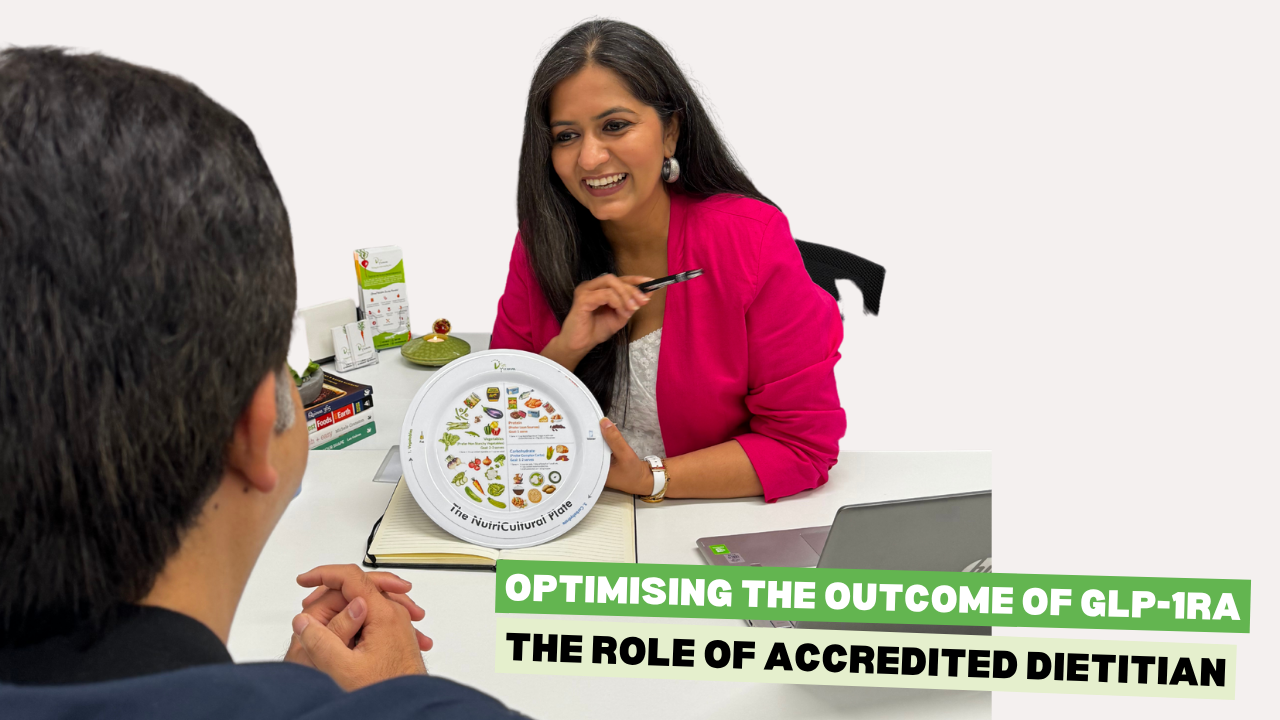

GLP‑1 receptor agonists (GLP‑1RAs) like Ozempic® and Mounjaro® are becoming increasingly popular for weight and blood sugar management—but they can come with nutritional downsides that are often overlooked. Here’s why having an Accredited Practising Dietitian (APD) as part of the care team is vital from the start.
Credits: Investigating nutrient intake during use of glucagon-like peptide-1 receptor agonist: a cross-sectional study, Johnson, B.,Frontiers in Nutrition, 12, 1566498
A study of 69 people on GLP‑1RAs found that many were falling short on a long list of nutrients—including vitamin D, calcium, iron, magnesium, potassium, vitamins A, C, E, K, choline, fibre and protein—when compared to recommended dietary intakes (DRIs).
Worryingly, nearly half weren’t receiving any nutritional guidance, and only 1 in 5 had seen an Accredited Dietitian.
Longer-term use of GLP‑1RAs is associated with vitamin D deficiency (~13%), low B vitamins (2–4%), nutritional anaemia, and muscle loss. Some clinical data suggest that 20–60% of total weight lost may come from lean muscle—not fat—especially in the absence of nutrition and exercise support.
People who had regular check-ins with an APD had higher rates of diagnosed deficiencies (29.8% vs 21.8%). This doesn’t mean they were worse off—it means the problems were picked up earlier and could be treated before they caused more serious health issues like fatigue, low immunity, or bone loss.
Leading nutrition organisations, including the Academy of Nutrition & Dietetics and international obesity care guidelines, recommend dietitian involvement in GLP‑1RA care. These medications affect the body much like bariatric surgery does—so the same level of nutritional care is warranted.
Ensuring enough protein, vitamins, and resistance exercise is key to preventing muscle and bone loss, which can otherwise sneak up during rapid weight changes.
APDs aren’t just about meal plans—they personalise care to make sure your body stays healthy while losing weight:
| Stage | Role of the Accredited Dietitian |
| Before starting | Nutrition assessment to check for any existing deficiencies (often common in obesity) |
| Early follow-up | Review food intake and tailor a plan to work around appetite changes |
| Mid-term (6–12 mo) | Review bloods (vitamin D, iron, B12), adjust supplements and support muscle maintenance |
| Ongoing care | Build long-term eating strategies, support healthy habits, and link in with exercise professionals |
GLP‑1RAs can be a powerful tool for weight and metabolic health—but they’re not without risks. Nutrient deficiencies and muscle loss are common, especially when people go it alone.
By bringing an Accredited Practising Dietitian into your care team early, you get expert guidance to support your body through each stage of the journey—keeping you strong, nourished, and on track for lasting success.
Disclaimer: The information provided in this blog is sourced from research articles and reputable websites. However, as each individual’s body and health needs are unique, it is essential to consult with your doctor, dietitian, or healthcare provider for personalised advice and plans tailored specifically to your condition.
Acknowledgement: I would like to extend my heartfelt gratitude to our CEO, Purva Gulyani – Accredited Practising Dietitian, for providing me with the opportunity to contribute to this blog. Your valuable feedback, along with your time spent proofreading and editing, has greatly enhanced the quality of this work. Your guidance and support are truly appreciated.
References:

Purva Gulyani – an Accredited Practising Dietitian and lifelong member of the Indian Dietitian Association. Currently pursuing PhD at Latrobe University. Purva brings over 16+ years of clinical dietitian experience to the table.




Commence your transformative journey to wellbeing today, taking the initial stride towards a healthier, happier you. Embrace constructive alterations that lead to a brighter and more vibrant future.
